DoubleSight DS-277W: Back to the Drawing Board
by Chris Heinonen on June 13, 2012 1:30 AM ESTStraight out of the box and set to 200 nits, the DS-277W offered pretty respectable performance with an average dE of only 6.46. Blues were the main issue, but the grayscale was pretty respectable without calibration, which is the most important aspect with the dE value.

Once calibrated to D65 with 2.2 gamma, the dE drops way down to 1.5 on average. Amazingly this is in line with the more expensive NEC PA271W that I had just tested. The grayscale was nice and flat, and the only colors with an error over 3 were those shades of blue we always see having issues. So despite those huge issues with the brightness level, if you keep yourself at a happy medium light output level, you can get good color results out of the DS-277W.
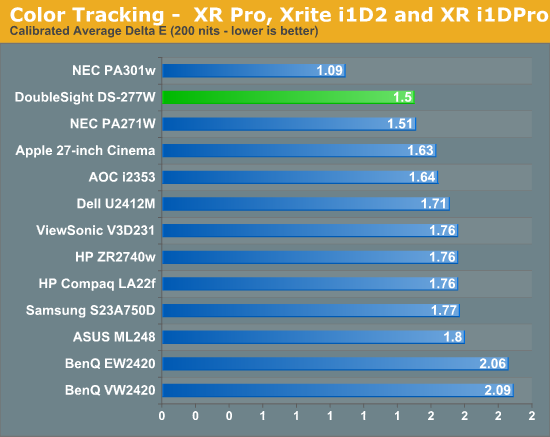
Median color error for 200 nits was the second-best that we have seen. Half of the colors have an error of 1 or less, rendering the difference totally invisible the eye, and a few poor colors are dragging the average way down. If you know what colors are causing this, this can be good as the grayscale and other colors will be accurate, you just need to know that blues will be more incorrect than other shades.

As mentioned on the brightness page, the lowest output level was 140 nits, which means the LUTs have to be adjusted down for reaching 100 nits of light output. This can be done, but shifting the levels to such a large degree can also lead to posterization, a lack of full dynamic range, and other issues with your output, and this is now video card dependant. Possibly because of this the 100 nits average dE rises up to over 2.0 from the 1.5 at 200 nits. Of course since this display only goes down to 140 nits, I would not recommend it for print work either, regardless of the dE value here.
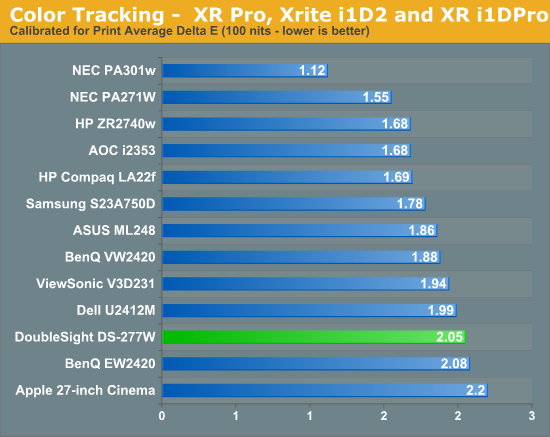
However, it does have a panel and backlighting system with a full AdobeRGB colorspace, and can display over 107% of the AdobeRGB standard. For editing images at 200 nits or so this will work well.
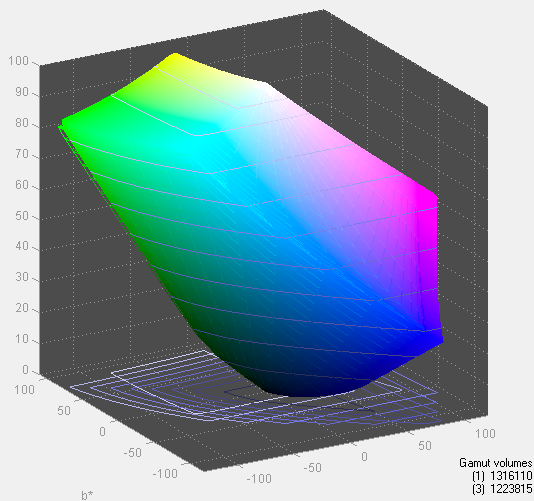
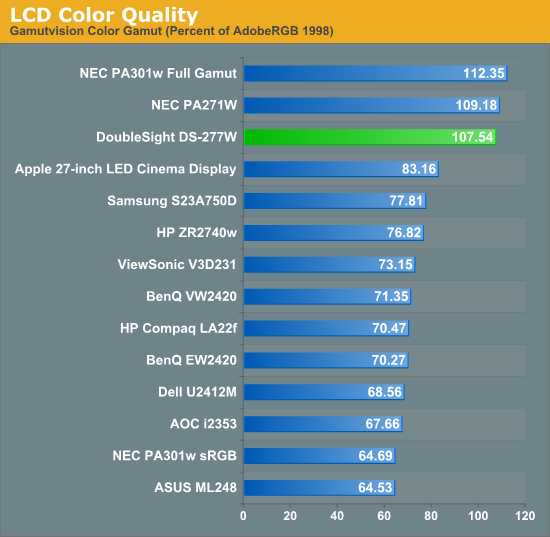


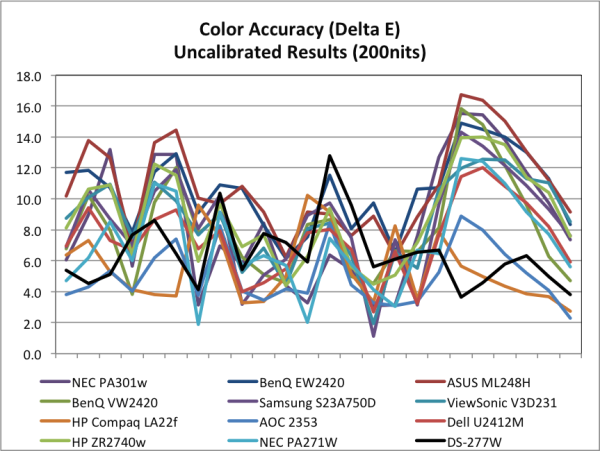
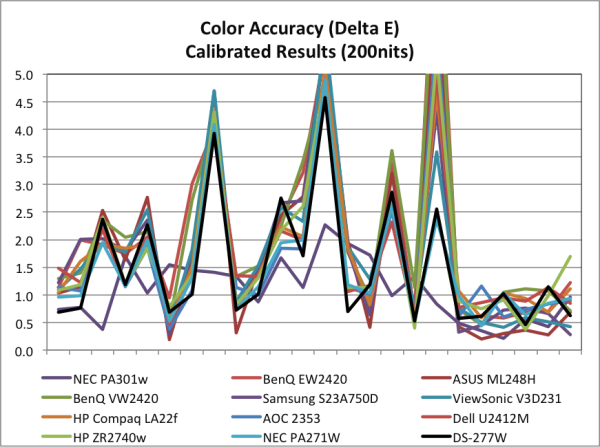
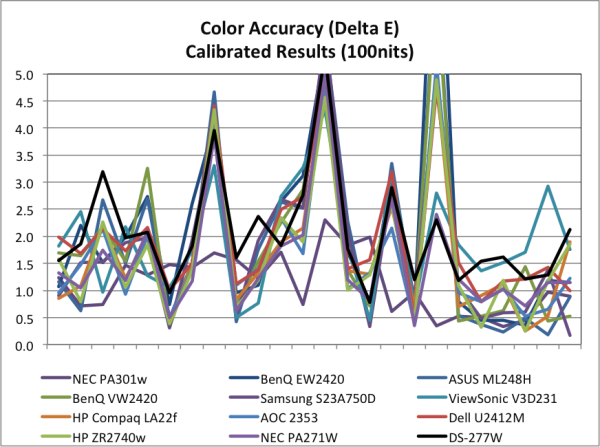








55 Comments
View All Comments
esSJae - Thursday, June 14, 2012 - link
FireWire was the only solution for external hard drives until USB 2 came out. I had FW on my Dell work laptop back in 2002.FireWire was also great because you could chain devices together.
Zoomer - Wednesday, June 13, 2012 - link
nVidia, AMD and Intel have all committed to DP. They will start the phase out of DVI, probably by going to just 1 TMDS per card. Why get something that's going to be a 2nd class interface standard really soon?Most cards, even lower end ones, have come with DP for years now.
Guspaz - Wednesday, June 13, 2012 - link
My current videocard has DP. My current monitor (a Dell U2711) has DP. My monitor came with a DP cable. As a result, I'm using DP to connect my monitor.There is, however, one major downside: if both HDMI and DP plugs are connected to an nVidia card, it boots on the HDMI port. This means that on my computer, I only see the BIOS and boot screens on my home theatre projector, not my LCD monitor... this is really dumb.
Zoomer - Saturday, June 16, 2012 - link
It's a software issue that will be fixed. Maybe ask nvidia/your card manufacturer?Dug - Wednesday, June 13, 2012 - link
Thunderbolt uses the same connection as display port (mini) so I don't see it going away.SodaAnt - Wednesday, June 13, 2012 - link
Well, I am that one person. I have a Dell Precision m4600 that I connect to my Dell u3011 with a displayport cable, no adapters involted.LordOfTheBoired - Wednesday, June 13, 2012 - link
I use DP. And I adopted it before Apple did.It's a good standard, and it deserves more support than it's getting right now.
Also, Apple's new "best interface ever" is Thunderbolt. Which... uses DP for video, and the now-standard mini-DP connector.
InsaneScientist - Wednesday, June 13, 2012 - link
Every single person I know who has a WQXGA (2560x1600) or WQHD (1560x1440) monitor (myself included) has it connected using Display Port.HDMI never seems to work despite the fact that HDMI 1.4 supposedly will, and dual-link DVI (as already mentioned) is a pain since you have to make sure that the port that you're connecting to is dual link and the cable is dual link...
An $8 Display Port cable just works... assuming that the monitor supports it.
Oh, and none of the people I know with monitors at that resolution are mac users, ironically enough.
JarredWalton - Thursday, June 14, 2012 - link
Apparently everyone with a 30" WQXGA or 27" WQHD display that you know also purchased their displays relatively recently (last couple of years). I've got a 30" display and it's using DL-DVI; same goes for most others with 30" displays that I've met (all five or so of them!) But for newer displays yes, DP is becoming far more mainstream.Voo - Saturday, June 16, 2012 - link
Actually I do use DL-DVI on my relatively new Dell U3011 - why?Because Dell included the DVI cable but no DP cable in the package and I really don't see any advantages in DP over DL-DVI.